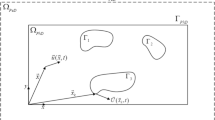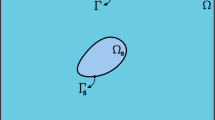Abstract
An adaptive version of immersed boundary method for simulating flows with complex stationary and moving boundaries is presented. The method employs a ghost-cell methodology which allows for a sharp representation of the immersed boundary. To simplify the implementation of the methodology, a volume-of-fluid method is introduced to identify the immersed boundary. In addition, the domain is spatially discretized using a tree-based discretization which is relatively simple to implement a fully flexible adaptive refinement strategy. Finally, the methodology is validated by comparing it with numerical and experimental results on three cases: (1) the flow passing a circular cylinder at Re=40 and Re=100, (2) a periodic oscillation of a circular cylinder in fluid at rest and (3) the self-propelled fish-like swimming at Re=6400.
Similar content being viewed by others
References
Peskin C S. Flow patterns around heart valves. J Comput Phys, 1972, 10: 252–271
Goldstein D, Handler R, Sirovich L. Modeling a no-slip flow boundary with an external force field. J Comput Phys, 1993, 105: 354–366
Saiki E M, Biringen S. Numerical simulation of a cylinder in uniform flow: Application of a virtual boundary method. J Comput Phys, 1996, 123: 450–465
Mittal R, Iaccarino G. Immersed boundary methods. Annu Rev Fluid Mech, 2005, 37: 239–261
Udaykumar H S, Mittal R, Shyy W. Computational of solid-liquid phase fronts in the sharp interface limit on fixed grids. J Comput Phys, 1999, 153: 535–574
Ye T, Mittal R, Udaykumar H S, et al. An accurate Cartesian grid method for viscous incompressible flows with complex immersed boundaries. J Comput Phys, 1999, 156: 209–240
Fadlun E A, Verzicco R, Orlandi P, et al. Combined immersed boundary finite-difference methods for three-dimensional complex flow simulations. J Comput Phys, 2000, 161: 35–60
Kim J, Kim D, Choi H. An immersed-boundary finite-volume method for simulations of flow in complex geometries. J Comput Phys, 2001, 171: 132–150
Tseng Y H, Ferziger J H. A ghost-cell immersed boundary method for flow in complex geometry. J Comput Phys, 2003, 192: 593–623
Shu C, Liu N, Chew Y T. A novel immersed boundary velocity correction-lattice Boltzmann method and its application to simulate flow past a circular cylinder. J Comput Phys, 2007, 226: 1607–1622
Mittal R, Dong H, Bozkurttas M, et al. A versatile sharp interface immersed boundary method for incompressible flows with complex boundaries. J Comput Phys, 2008, 227: 4825–4852
Wu C J, Wang L. Numerical simulations of self-propelled swimming of 3D bionic fish school. Sci China Ser E-Tech Sci, 2009, 52: 658–669
Wu C J, Wang L. Where is the rudder of a fish? The mechanism of swimming and control of self-propelled fish school. Acta Mech Sin, 2010, 26: 45–65
Popinet S. Gerris: A tree-based adaptive solver for the incompressible Euler equations in complex geometries. J Comput Phys, 2003, 190: 572–600
Brown D L, Cortez R, Minion M L. Accurate projection methods for the incompressible Navier-Stokes equations. J Comput Phys, 2001, 168: 464–499
Bell J B, Colella P, Glaz H M. A second-order projection method for the incompressible Navier Stokes equations. J Comput Phys, 1989, 85: 257–283
Lai M, Peskin C S. An immersed boundary method with formal second-order accuracy and reduced numerical viscosity. J Comput Phys, 2000, 160: 705–719
Dias A, Majumdar S. Numerical computation of flow around a circular cylinder. Technical Report, PS II Report, BITS Pilani, India, 2002
Zdravkovich M M. Flow Around Circular Cylinders. Vol. 1: Fundamentals. New York: Oxford University Press, 1997
Dütsch H, Durst F, Becker S, et al. Low-Reynolds-number flow around an oscillating circular cylinder at low Keulegan-Carpenter numbers. J Fluid Mech, 1998, 360: 249–271
Videler J J, Hess F. Fast continuous swimming of two pelagic predators, saithe (Pollachius virens) and mackerel (Scomber scombrus): A kinematic analysis. J Exp Biol, 1984, 109: 209–228
Fish F E, Lauder G V. Passive and active flow control by swimming fishes and mammals. Annu Rev Fluid Mech, 2006, 38: 193–224
Author information
Authors and Affiliations
Corresponding author
Rights and permissions
About this article
Cite this article
Wang, L., Wu, C. An adaptive version of ghost-cell immersed boundary method for incompressible flows with complex stationary and moving boundaries. Sci. China Phys. Mech. Astron. 53, 923–932 (2010). https://doi.org/10.1007/s11433-010-0185-z
Received:
Accepted:
Published:
Issue Date:
DOI: https://doi.org/10.1007/s11433-010-0185-z




